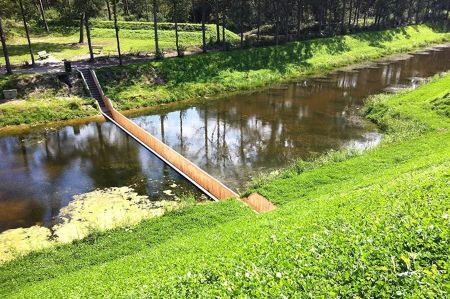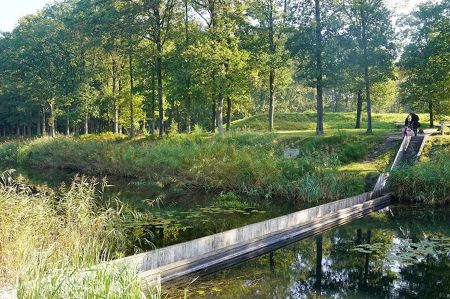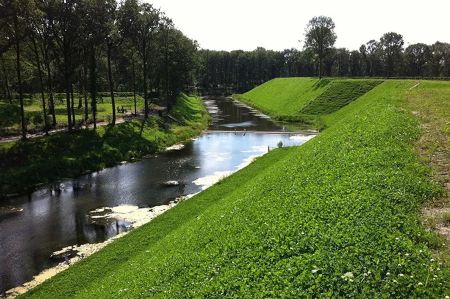Sunken bridge on the West-Brabantse Waterlinie
- Written by Portal Editor
The eyes do not deceive, because it actually looks as if the water has divided and the visitor can walk over the water. The biblical saying of Moses became a reality!
In the park-like setting of the West-Brabantse Waterlinie is an incredible 'sunken' bridge that offers visitors what is arguably a unique opportunity to reach a 17th-century Dutch fort seemingly by walking across the water. In the 17th century a number of forts and moats were built along the West Branbant waterline (we recently reported on Schenkenschanz Fort). Fort De Roovere is also an earth fort built as part of the Dutch Water Line, a series of water-based defences designed by Maurice of Nassau in 1628 during the Eighty Years' War to defend against Spanish invaders. Fort de Roovere was surrounded by a shallow moat, too deep to march through but too shallow for boats to swim on.
Friends of Fort de Roovere
 In 1747, during the War of the Austrian Succession (1740-1748), the fortress was besieged by the French. This siege was well documented. Eventually the fortress of Bergen op Zoom fell and the siege of Fort de Roovere was broken off.
In 1747, during the War of the Austrian Succession (1740-1748), the fortress was besieged by the French. This siege was well documented. Eventually the fortress of Bergen op Zoom fell and the siege of Fort de Roovere was broken off.
During the Napoleonic Wars, Bergen op Zoom was besieged again, this time by the English, who drove the French home. During this period Fort de Roovere appears to have been maintained but was not attacked. After the end of this conflict, the fortress was abandoned.
Fort de Roovere has fallen into disrepair over the years, but a foundation has now been set up, Friends of Fort de Roovere, with the aim of ensuring that the fort is not forgotten. The improvements include recreational features and the site contains multiple routes for biking and hiking.
Moses Bridge consists of Accoya
 As part of a renovation project, Fort de Roovere, the largest fort in the complex, received an access bridge. This fortress is also surrounded by a moat and originally had no bridge, which in this case would also have spoiled the view of the complex. The task of the planners was therefore to design a bridge construction that was as inconspicuous as possible. Architects Ro Koster and Ad Kil's solution was a "sunken" bridge that follows the embankment line and ends level with the wall and the water table - "Moses Bridge". It is practically invisible when approaching the fort.
As part of a renovation project, Fort de Roovere, the largest fort in the complex, received an access bridge. This fortress is also surrounded by a moat and originally had no bridge, which in this case would also have spoiled the view of the complex. The task of the planners was therefore to design a bridge construction that was as inconspicuous as possible. Architects Ro Koster and Ad Kil's solution was a "sunken" bridge that follows the embankment line and ends level with the wall and the water table - "Moses Bridge". It is practically invisible when approaching the fort.
Moses Bridge consists of Accoya wood sheet piling on both sides, a hardwood deck and steps inserted in between. Accoya wood's durability and guaranteed performance in both soil and water make this possible. Acetylated wood is wood that has been treated with acetic anhydride in a chemical wood modification process to make it more difficult for wood-destroying fungi or insects to colonize it, thereby extending its useful life outdoors. Acetic acid is not toxic, so the recycling and disposal of the wood is still possible without restrictions. Acetylated wood also hardly absorbs moisture, which improves dimensional stability and durability.
Halsteren Netherlands
Fort de Roovere
Coordinates: 51°31′44″N 4°18′04″E
Please read as well:
From the Bastei Bridge to Hohnstein - hello to Kasper
Campers at Pozar Loutraki Aridea Thermal Spa
